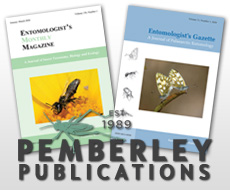Entomologist's Monthly Magazine - Vol. 161, No. 1, 2025
Published: 1/31/2025
Article Details for this issue
EDITORIAL
By: ANDREW WAKEHAM-DAWSON & IAN JOHNSON
Page: 1
Type: Editorial
Migration of Belenois aurota (Fabricius) (Lepidoptera: Pieridae) in Syria: implications for the caper industry?
By: EDDIE JOHN, WA’EL ALMATNI & MUDAR SALIMEH
Page: 2–12
Type: Paper
Synopsis:
We report on migration/dispersal in Syria of Belenois aurota, a tropical migrant pierid. The routes followed to the east of the Anti-Lebanon and Silsilat al-Jibal as-Sa?iliyah (Latakia) mountain ranges, indicate the use of previously undocumented migratory pathways into northwestern Syria with potential for further incursion into Mediterranean provinces of Türkiye. The hostplants in Syria are species of Capparis, a source of economic benefit to those foraging caper buds in northwestern governates of the country. However, we consider the threat to Capparis spp. posed by migrant B. aurota currently to be secondary to that of the proliferating Stenozygum coloratum, now a very common resident pentatomid (Hemiptera).
Dolichomitus quercicolus Zwakhals (Hymenoptera: Ichneumonidae: Pimplinae) new to Britain
By: JASWINDER S. BOPARAI
Page: 13–20
Type: Paper
Synopsis:
Dolichomitus quercicolus Zwakhals, 2010, is recorded for the first time in Britain, based on female and male specimens collected from Bell Coppice, Shropshire. Both sexes and their distinguishing features are photographed with notes on their identification and published hosts. Some records are listed of the scarcer wood-boring parasitoids, along with additional species of Dolichomitus, which have been found in Bell Coppice.
First report of the Slug Mite Riccardoella oudemansi Thor (Acari: Ereynetidae) in Cyprus
By: DEMETRIS KOLOKOTRONIS, WATARU NAGATA & TSUKASA WAKI
Page: 21–28
Type: Paper
Synopsis:
The slug mite Riccardoella oudemansi Thor, 1932, is reported for the first time from Cyprus. Two terrestrial mollusc species: Limacus flavus (Linnaeus, 1758) (Limacidae) and, tentatively, Carpathica cf. cretica (Forcart, 1950) (Oxychilidae) are reported as hosts. The mites were identified on the basis of palps and leg chaetotaxy, and morphological characters including the shape of famulus on tibia I. Results of an initial molecular analysis are presented. Other Riccardoella species may be present in Cyprus.
Range expansion in Western Pygmy Blue butterfly Brephidium exilis (Boisduval), with records from the Red Sea coast and north-west Saudi Arabia (Lepidoptera: Lycaenidae)
By: BINISH ROOBAS, GARY R. FEULNER, OSCAR CAMPBELL & PRANAY HIRLEKAR
Page: 29–39
Type: Paper
Synopsis:
The Western Pygmy Blue Brephidium exilis (Boisduval), a North American butterfly that began its overseas expansion in Arabia more than thirty years ago, was recently observed for the first time at two sites in the western part of the Kingdom of Saudi Arabia: (i) a wintertime record of a few individuals in near-freezing temperatures at a peri-agricultural site outside the north-western desert city of Tabuk, and (ii) a large population among extensive urban landscaping along the central Red Sea coast north of Jeddah, similar to sites where it flourishes in eastern Arabia. These observations (a) fill a large observational gap in the expanding range of this non-native species in the Middle East, South-west Asia and even North Africa; (b) demonstrate the breadth of its ecological tolerance; and (c) indicate its potential for continued dispersal, including the possibility that it may already be established at other urban sites in the growing cities in the west of the Kingdom.
SHORT NOTE A correction on the taxonomic identity of Succinapis (Hymenoptera: Apidae)
By: MICHAEL S. ENGEL
Page: 40–44
Type: Short Notes
Morphological examination of Anthrenus oceanicus Fauvel (Coleoptera: Dermestidae: Megatominae)
By: GRAHAM J. HOLLOWAY
Page: 45–56
Type: Paper
Synopsis:
A morphological examination of Anthrenus oceanicus Fauvel is presented. This species is considered a member of the Palaearctic Anthrenus pimpinellae species complex. Descriptions and images of habitus features, male terminalia, and sclerites within the bursa copulatrix are presented. The distribution of A. oceanicus is provided. Anthrenus oceanicus differs in many respects from all other members of the A. pimpinellae species complex. The conclusion is that A. oceanicus belongs to a different taxonomic lineage than the rest of the A. pimpinellae complex species.
A panurgine bee from the middle Miocene of Öhningen, Germany (Hymenoptera: Andrenidae)
By: MICHAEL S. ENGEL
Page: 57–63
Type: Paper
Synopsis:
The bee subfamily Panurginae is reported for the first time from the middle Miocene crater lake of Öhningen, southwestern Germany (Baden-Württemberg: Konstanz). A single specimen, likely a male, is preserved as a rather faint compression in limestone and was labelled more than 75 years ago as possibly Osmia Panzer. The fossil is certainly one of the less-well preserved bees from the Öhningen locality and is the kind of specimen that might quickly be relegated to incertae sedis and passed over for better material. However, close inspection with sufficient lighting reveals subtle characters divulging the fossil’s identity. In fact, the bee is of the tribe Panurgini and is here described as a new subgenus and species therein. Panurgus (Chronopanurgus) tribacus subgen. & sp. n. is distinguished from other panurgines, thereby representing not only the first panurgine fossil from Öhningen but from all Eurasia.
Lepidoptera of the Falkland Islands (10): First record of Coleophora Hübner (Coleophoridae)
By: ANDREW WAKEHAM-DAWSON
Page: 64–70
Type: Paper
Synopsis:
This paper provides the first record of a coleophorid moth from the Falkland Islands: Coleophora breyeri Pastrana, where it is most probably resident, although further research is required. Habitat and behaviour of C. breyeri are compared with that of Acrolepiopsis madeleinae Wakeham-Dawson & Gaedike, as an aid to recording the species in the field.
BOOK REVIEW SOLITARY BEES by T. Benton & N. Owens
By: MICHAEL S. ENGEL
Page: 71–72
Type: Book Review



